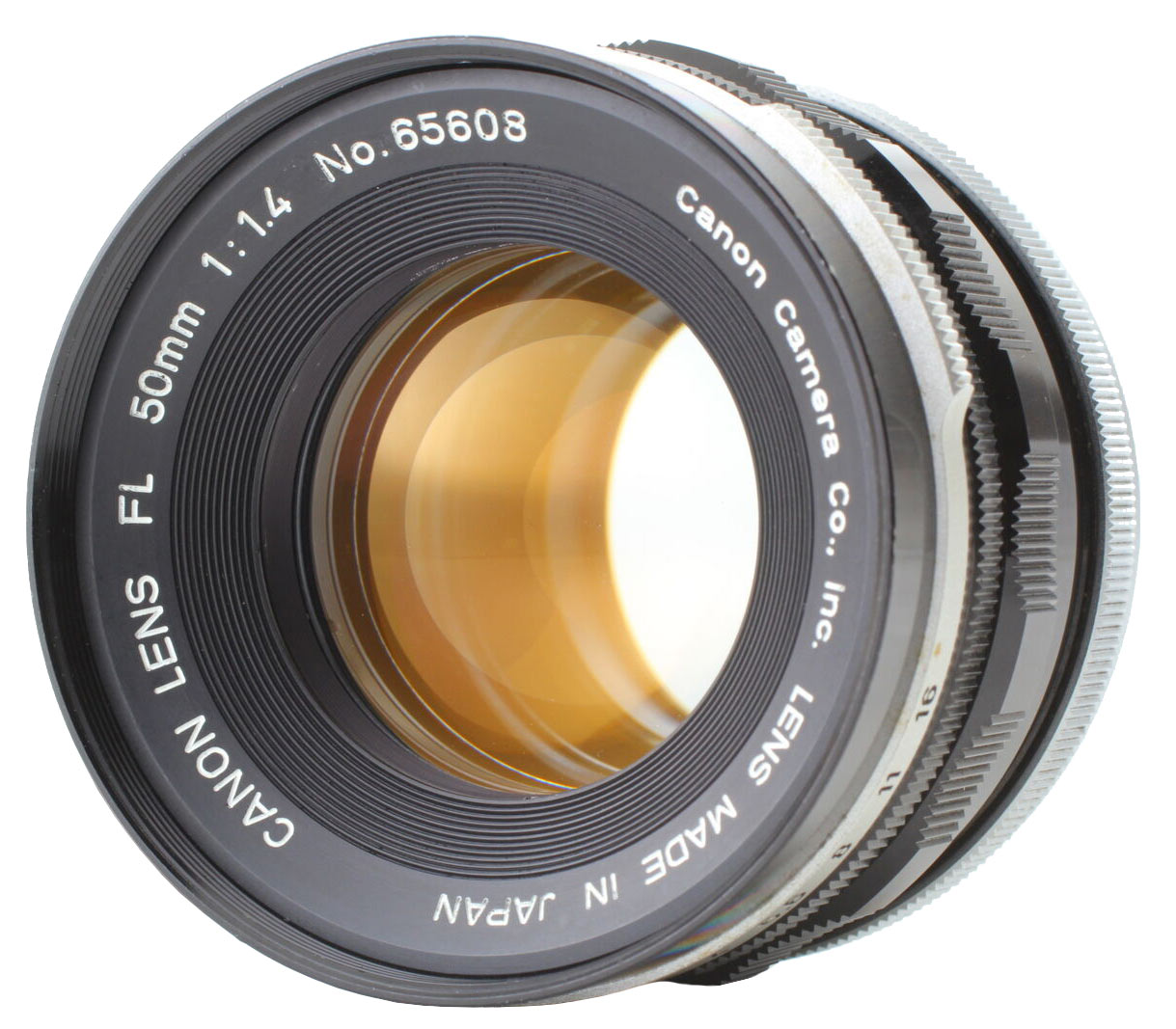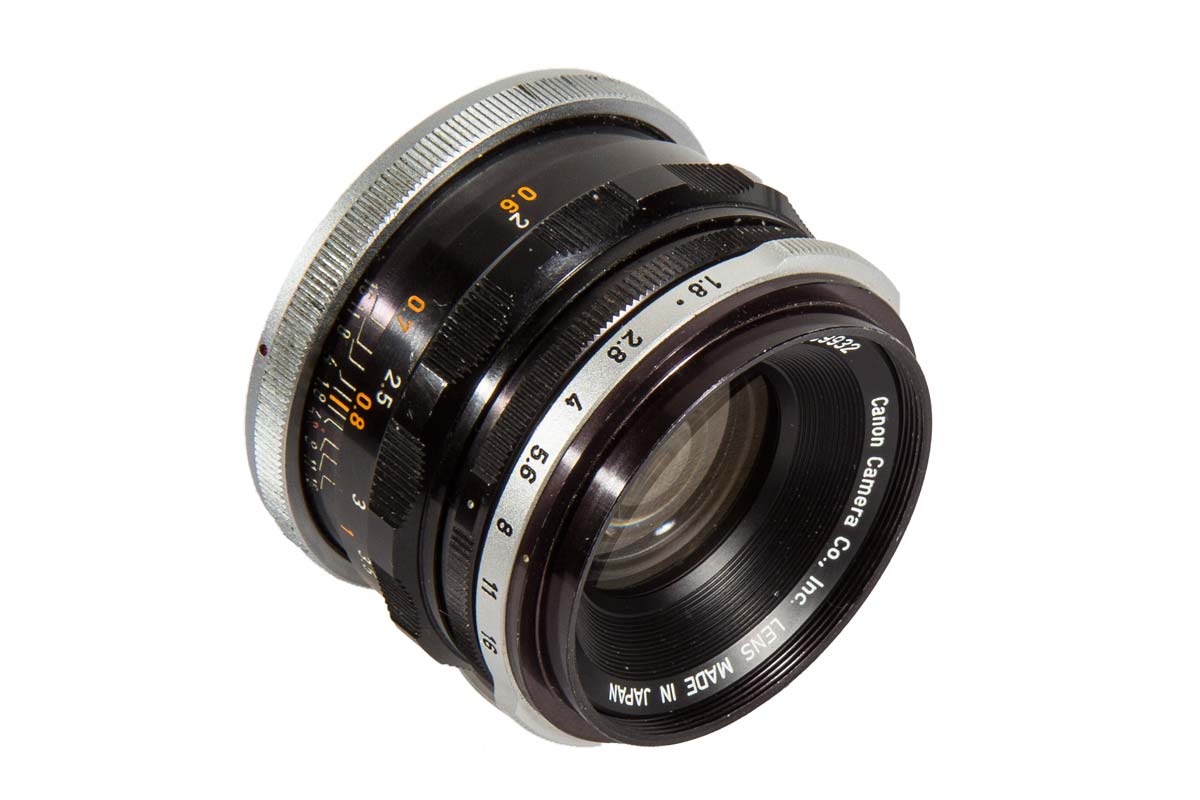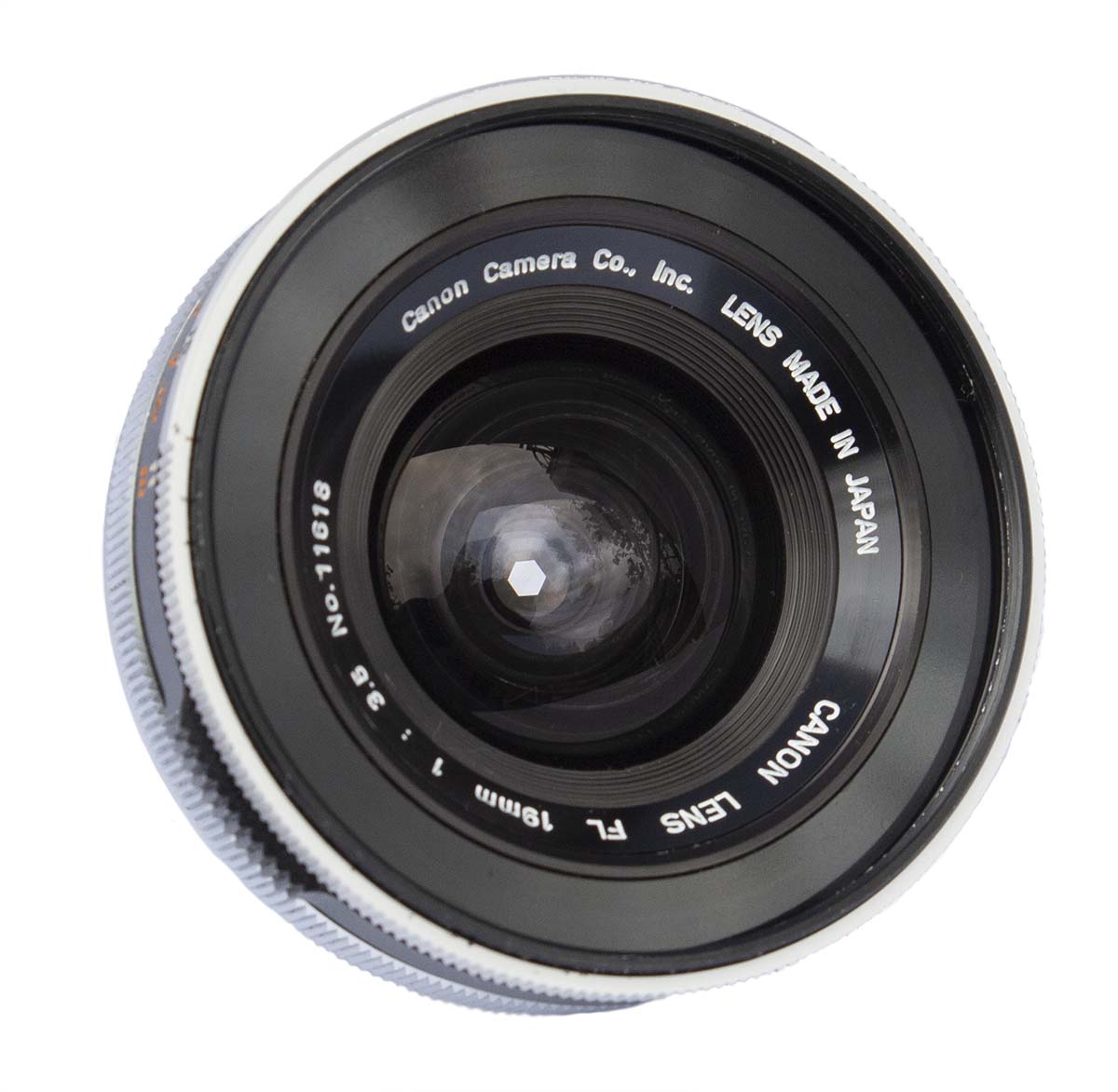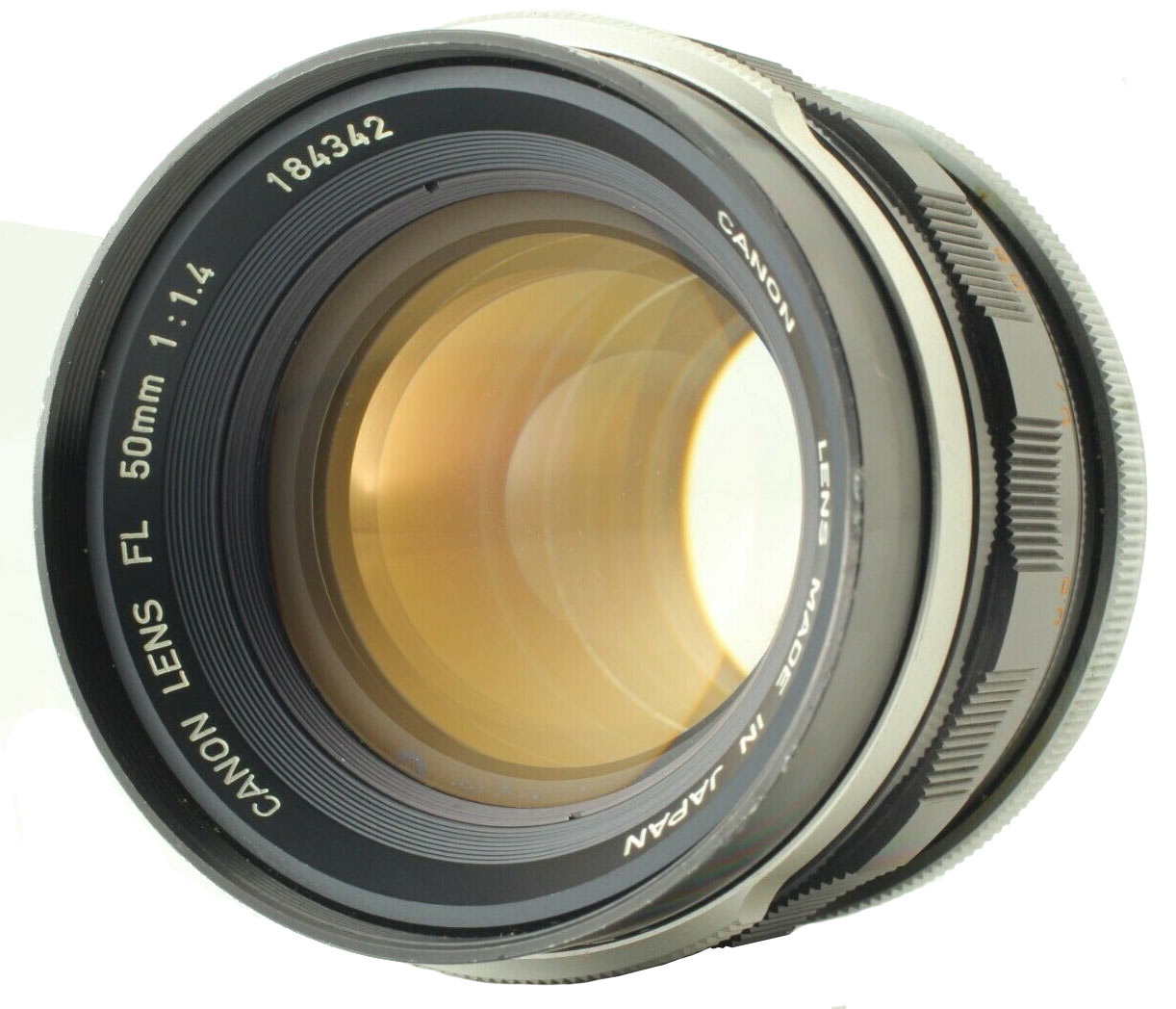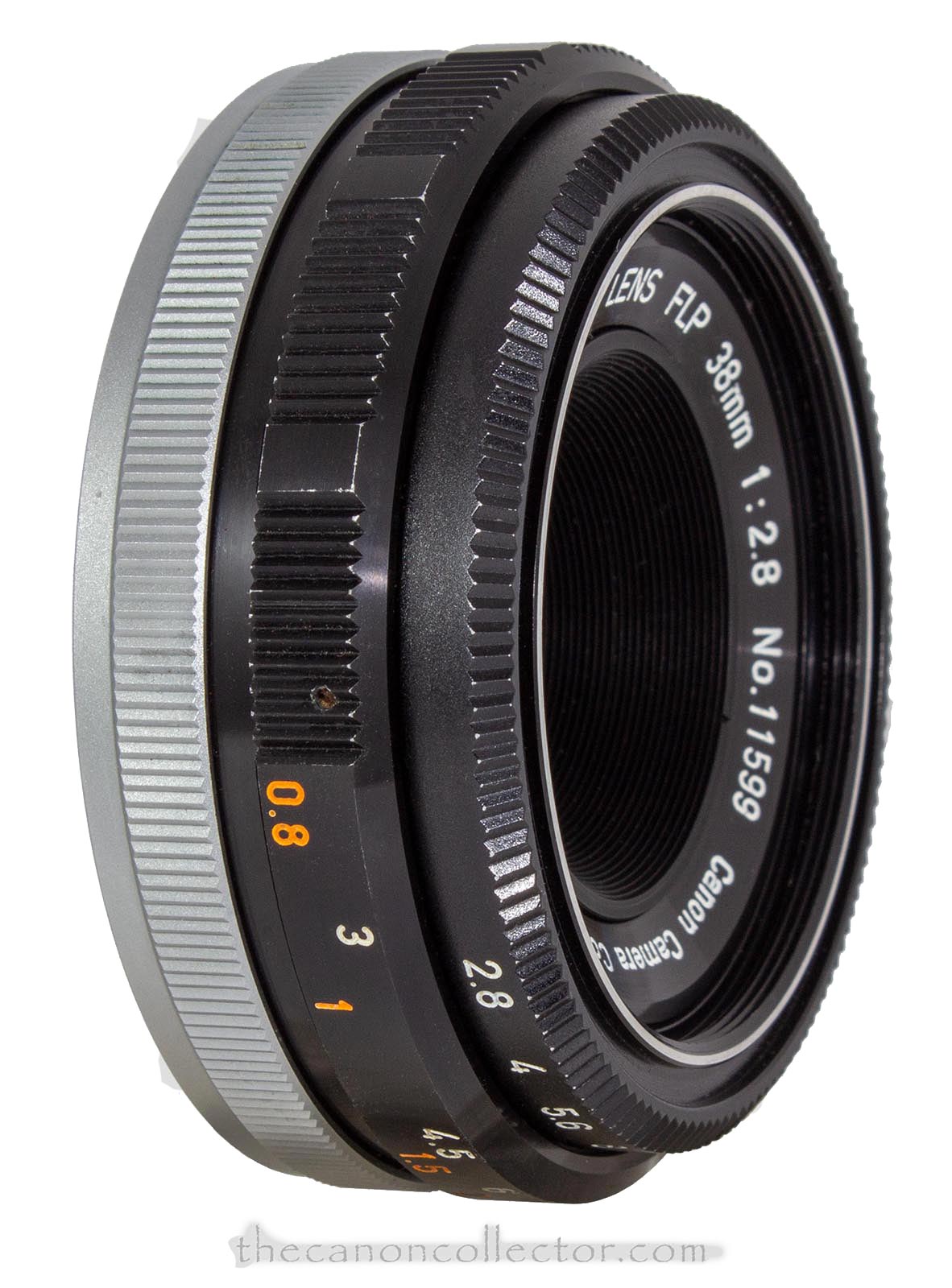This is the FL 50mm f/1.4 introduced in April of 1965. This lens actually came in three versions of which this is the first.
The FL Series Lenses
Eyes for the F Series Cameras
When Canon brought out its first SLR in in 1959 lenses did not communicate with the camera body. But there was a problem: easiest focusing was done with the lens wide open but the iris had to be closed for the exposure. That involved the camera body sending a signal to the lens. The era of communication between lens and camera began.
The original Canon SLR’s, the Canonflex series, came out with a new lens mount called the “R” mount. Through the lens metering still lay in the future but the photographer could set the aperture on
the lens but it would not close down. It remained at full aperture. Then when the shutter fired the aperture closed for a brief instant while the shutter was open and then it returned to full aperture.
Canon found a way to simplify the R mount and in April of 1964 they introduced the “FL” lens mount on the Canon FX camera. This was the introduction of the impressive F series of cameras.
As cameras developed Through the Lens Metering (TTL) became the next big thing and this had to be done at full aperture and what that aperture was had to be communicated to the camera. The FL mount could not do this. . And so in March of 1971 the FL Mount was replaced by the “FD” mount introduced on the original F-1 camera body.
The last camera body to have the FL mount was the Canon TL introduced in 1968. 1964 to 1968 is not a long time for something as basic as a lens mount to be offered but camera competition and development at this time was frenetic. The camera companies were leapfrogging over each other to offer new features. In all there were 33 FL lenses of all focal lengths brought to market in that short span of time.
The letters FL and FD apparently have no particular meaning and I have not seen any explanation of why these designations were chosen.
This lens design was based on the concept that the lens not turn as it was mounted on the camera so that the mating surfaces would not wear against each other and to simplify the engagement of the aperture pin on the rear surface of the lens. This was accomplished by putting a “Breach Lock Ring” on the back of the lens that turned without turning the lens to engage locking lugs on the camera body.

On the back (to the left) of this lens you can see the “Breach Lock Ring”. On the front (to the right) you can see the silver aperture setting ring.

The single pin on the back of an FL lens is shown. Note how uncluttered the back of an FL lens looks. The locking lugs on the Breach Lock Ring are clearly visible.
The distinguishing features of this lens, aside from the “FL” letters inscribed in the front lens ring, are the two silver rings, the Breach Lock Ring and the Aperture Selection Ring, that are visible in the picture to the left and the single Automatic Aperture Pin protruding from the back of the lens. It is easily recognized.
The desired f/stop is selected on the Aperture Selection Ring but the lens remains wide open. When the shutter is pressed the camera body has a lever that engages the Automatic Aperture Pin and the lens shuts down to the previously selected f/stop. Then the shutter curtain is released, the exposure is made, and the lens reopens to full aperture. It happens in the blink of an eye.
This predates automatic exposure settings and so the only information communicated to the lens is that the shutter is about to fire and the lens must stop down. Thus a single pin suffices.
The neat clean appearance of the rear surface of the lens is a clear giveaway that this is an FL lens. So now you too can recognize what you are looking at when you hold an FL lens at a camera show!
The distinguishing features of this lens, aside from the “FL” letters inscribed in the front lens ring, are the two silver rings, the Breach Lock Ring and the Aperture Selection Ring, that are visible in the picture to the left and the single Automatic Aperture Pin protruding from the back of the lens. It is easily recognized.
The desired f/stop is selected on the Aperture Selection Ring but the lens remains wide open. When the shutter is pressed the camera body has a lever that engages the Automatic Aperture Pin and the lens shuts down to the previously selected f/stop. Then the shutter curtain is released, the exposure is made, and the lens reopens to full aperture. It happens in the blink of an eye.
This predates automatic exposure settings and so the only information communicated to the lens is that the shutter is about to fire and the lens must stop down. Thus a single pin suffices.
The neat clean appearance of the rear surface of the lens is a clear giveaway that this is an FL lens. So now you too can recognize what you are looking at when you hold an FL lens at a camera show!
| No. | Name | Released | Min.Aperture | Blades | Groups | Elements | Filter | Weight |
| 1 | FL 35mm f/2.5 | Mar 64 | 16 | 6 | 5 | 7 | 58mm | 352gr |
| 2 | FL 50mm f/1.8 (I) | Mar 64 | 16 | 6 | 4 | 6 | 48mm | 228gr |
| 3 | FL 58mm f/1.2 (I) | Mar 64 | 16 | 8 | 5 | 7 | 58mm | 410gr |
| 4 | FL 200mm f/3.5 (I) | Mar 64 | 22 | 8 | 5 | 7 | 58mm | 660gr |
| 5 | FL 55-135mm f/3.5 | Mar 64 | 22 | 8 | 10 | 13 | 58mm | 780gr |
| 6 | FL 19mm f/3.5 | Aug 64 | 16 | 6 | 7 | 9 | 58mm | 150gr |
| 7 | FL 85mm f/1.8 | Sep 64 | 16 | 8 | 4 | 5 | 58mm | 445gr |
| 8 | FL 100mm f/3.5 | Oct 64 | 22 | 6 | 4 | 5 | 48mm | 278gr |
| 9 | FL 50mm f/1.4 | Apr 65 | 16 | 8 | 4 | 6 | 58mm | 280gr |
| 10 | FL 85-300mm f/5 | Apr 65 | 22 | 6 | 9 | 15 | 72mm | 1850gr |
| 11 | FLP 38mm f/2.8 | May 65 | 16 | 6 | 3 | 4 | 48mm | 210gr |
| 12 | FL 135mm f/2.5 | May 65 | 16 | 8 | 4 | 6 | 58mm | 645gr |
| 13 | FLM 50mm f/3.5 | Jun 65 | 22 | 6 | 3 | 4 | 58mm | 295gr |
| 14 | FL 19mm f/3.5R | Nov 65 | 16 | 6 | 9 | 11 | Series IX | 500gr |
| 15 | FL 58mm f/1.2 (II) | Mar 66 | 16 | 8 | 5 | 7 | 58mm | 410gr |
| 16 | FL 200mm f/3.5 (II) | May 66 | 22 | 8 | 5 | 7 | 58mm | 680gr |
| 17 | FL 50mm f/1.4 (I) | Sep 66 | 16 | 8 | 5 | 6 | 58mm | ? |
| 18 | FL 135mm f/3.5 | Sep 66 | 22 | 8 | 3 | 4 | 48mm | 434gr |
| 19 | FL 200mm f/4.5 | Sep 66 | 22 | 8 | 4 | 5 | 48mm | 555gr |
| 20 | FL 28mm f/3.5 | Dec 66 | 16 | 6 | 7 | 7 | 58mm | 240gr |
| 21 | FL 100-200mm f/5.6 | Dec 66 | 22 | 8 | 5 | 8 | 55mm | 650gr |
| 22 | FL 50mm f/1.8 (II) | Mar 68 | 16 | 6 | 4 | 6 | 48mm | 280gr |
| 23 | FL 35mm f/3.5 | May 68 | 16 | 6 | 6 | 6 | 48mm | 270gr |
| 24 | FL 50mm f/1.4 (II) | May 68 | 16 | 8 | 6 | 7 | 58mm | 340gr |
| 25 | FL 55mm f/1.2 | Jul 68 | 16 | 8 | 5 | 7 | 58mm | 480gr |
| 26 | FL-F 300mm f/5.6 | Mar 69 | 22 | 8 | 6 | 7 | 58mm | 850gr |
| 27 | FL-F 500mm f/5.6 | Jun 69 | 22 | 6 | 5 | 6 | 95mm | 2700gr |
| 28 | FLM 100mm f/4 | Sep 69 | 22 | 8 | 3 | 5 | 48mm | 220gr |
| 29 | FL 400mm f/5.6 | Sep 71 | 32 | 8 | 4 | 5 | 48mm | 3890gr |
| 30 | FL 600mm f/5.6 | Sep 71 | 32 | 8 | 5 | 6 | 48mm | 5000gr |
| 31 | FL 800mm f/8 | Sep 71 | 32 | 8 | 5 | 7 | 48mm | 5360gr |
| 32 | FL 1200mm f/11 | Jun 72 | 64 | 8 | 5 | 7 | 48mm | 6200gr |
| 33 | FL 300mm f/2.8 S.S.C. Florite | Feb 74 | 32 | 12 | 5 | 6 | – | 2340gr |
FL Lenses in the Collection
Here are some of the FL lenses I have been able to acquire so far. It is a time consuming process to shop on Craig’s List and E-bay. And of course I am working on a budget. It would be no fun if I just went out and bought one of everything. Where would the thrill of the hunt be? I would miss the satisfaction of finding a good bargain.
I have more than you see here because it takes time and work to get them all listed.
This website is the work of R. Flynn Marr who is solely responsible for its contents which are subject to his claim of copyright. User Manuals, Brochures and Advertising Materials of Canon and other manufacturers available on this site are subject to the copyright claims and are the property of Canon and other manufacturers and they are offered here for personal use only.

